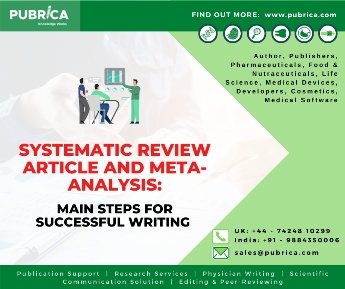
How to search keywords in Google scholar for your Research
August 2, 2021
Systematic Review and Meta Analysis Main Steps for Successful Writing
August 9, 2021In Brief
According to the, a systematic review is “a scholarly method in which all empirical evidence that meets pre-specified eligibility requirements is gathered to address a particular research question.” It entails systematically identifying, selecting, synthesising, and evaluating primary research studies to produce a high-quality summary of a subject while addressing a pre-specified research question. A meta-analysis is a step forward from a systematic review in that it employs mathematical and statistical methods to summarise the results of studies included in the systematic review(1).
Introduction
In some aspects, systematic reviews vary from conventional narrative reviews. Narrative reviews are mostly descriptive, do not require a systematic search of the literature, and concentrate on a subset of studies in a field selected based on availability or author preference. As a result, although narrative reviews are informative, they often include an element of selection bias. As the name implies, systematic reviews usually include a thorough and comprehensive plan and search strategy derived a priori to minimise bias by finding, evaluating, and synthesising all related studies on a given subject. A meta-analysis aspect is often used in systematic reviews, which entails using statistical techniques to synthesise data from several studies into a single quantitative estimation or summary effect size. It is a well-known and well-respected multinational non-profit organisation that promotes, funds, and disseminates systematic reviews and meta-analyses on the effectiveness of healthcare interventions (2).
Need of systemic review and meta-analysis:
There are several reasons for performing a systematic review and meta-analysis:
- It may assist in resolving discrepancies in results published by individual studies that may include bias or errors.
- It may help identify areas in a field where there is a lack of evidence and areas where further research should be conducted.
- It allows the combination of findings from different studies, highlighting new findings relevant to practice or policy.
- It may be able to reduce the need for additional trials.
- Writing a systematic review and meta-analysis will help identify a researcher’s field of interest since they are published in high-impact journals and receive many citations (3).
Phases to planning a systematic review and meta-analysis
The succeeding components to a successful systematic review and meta-analysis writing are:
- Formulate the Review Question
The first stage involves describing the review topic, formulating hypotheses, and developing a title for the review. It’s usually best to keep titles as short and descriptive as possible by following this formula: Intervention for those with a disease (e.g., Dialectical behaviour therapy for adolescent females with a borderline personality disorder). Since reviews published in other outlets do not need to be listed as such, they should state in the title that they are a systematic review and meta-analysis.
- Define inclusion and exclusion criteria
The PICO (or PICOC) acronym stands for population, intervention, comparison, outcomes (and context). It can help ensure that all main components are decided upon before beginning the study. Authors must, for example, choose their population age range, circumstances, results, and type(s) of interventions and control groups a priori. It’s also crucial to determine what types of experiments to include and exclude (e.g., RCTs only, RCTs and quasi-experimental designs, qualitative research), the minimum number of participants in each group, published and unpublished studies, and language restrictions.
- Develop a search strategy and locate studies
This is where a reference librarian can be particularly beneficial in assisting with the creation and execution of electronic searches. To recognise all applicable trials in a given region, it is essential to create a detailed list of key terms (i.e., “MeSH” terms) related to each component of PICOC. The secret to creating an effective search strategy is to strike a balance between sensitivity and precision.
- Selection of studies
After retrieving and reviewing a detailed list of abstracts, any studies that tend to satisfy inclusion requirements will be collected and thoroughly reviewed. To ensure inter-raterreliability, this procedure is usually carried out by at least two reviewers. It is suggested that authors maintain a list of all checked research, including reasons for inclusion or exclusion. It might be possible to hire study authors to collect missing data for data pooling (e.g., means, standard deviations). It’s also possible that translations will be needed.
- Extract data
To organise the information extracted from each reviewed study (e.g., authors, publication year, number of participants, age range, study design, results, included/excluded), building and using a basic data extraction type or chart can be beneficial. Data extraction by at least two reviewers is necessary to ensure inter-rater reliability and prevent data entry errors.
Table: 1 outline for systemic review and meta-analysis
| Background | |
| Objectives | |
| Review questions | Types of patients, interventions, outcomes and studies |
| Search strategy | Databases, study period, grey literature |
| Review Methods | |
| Databases and article sources | |
| Screening | |
| Data extraction | |
| Assessment of data quality | |
| Data analysis | |
| References |
- Assess study quality
In recent years, there has been a push to improve the consistency of each RCT included in systematic reviews. Double-blinding, which is acceptable for clinical trials but not for psychological or non-pharmacological treatments, significantly impacts this metric. Other more detailed guidelines and criteria, such as the Consolidated Standards of Reporting Trials (CONSORT), as well as articles with recommendations for improving quality in RCTs and meta-analyses for psychological intervention, are available(4).
- Analyse and Interpret results
The Review Manager (RevMan) software, endorsed by the Cochrane Collaboration, is one example of a statistical programme that can measure effect sizes for meta-analysis. The effect sizes are given, along with a 95 percent confidence interval (CI) range, and are presented in both quantitative and graphical form (e.g., forest plots). Each trial is visually represented as a horizontal diamond shape in forest plots. The middle represents the effect size (e.g., SMD) and the endpoints representing both ends of the CI.
- Disseminate findings
Since the Cochrane Collaboration’s reviews are published in the online Cochrane Database of Systematic Reviews, they are often lengthy and comprehensive. As a result, it is possible and encouraged to publish abbreviated versions of the review in other applicable scholarly journals; indeed, engaging in a review update or joining a well-established review team may be a beneficial way to get involved in the systematic review process.
Future scope
The systematic review’s findings should be discussed in terms of the strength of evidence and shortcomings of the initial research used for the review. It’s also necessary to discuss the review’s weaknesses, the results’ applicability (generalizability), and the findings’ implications for patient care, public health, and future clinical research (5).
Conclusion
The steps of a systematic review/meta-analysis include developing a research question and validating it, forming criteria, searching databases, importing all results to a library and exporting to an excel sheet, protocol writing and registration, title and abstract screening, full-text screening, manual searching, extracting data and assessing its quality, data checking, and conducting statistics. The PRISMA or Meta-analysis must be used to write up the systematic study and meta-analysis. This is a reporting checklist for systematic literature reviews and meta-analyses that specifies what information should be included in each portion of a high-quality systematic review (6).
References
- Alonso Debreczeni, Felicia, and Phoebe E. Bailey. “A systematic review and meta-analysis of subjective age and the association with cognition, subjective well-being, and depression.” The Journals of Gerontology: Series B 76.3 (2021): 471-482.
- Vasconcellos, Diego, et al. “Self-determination theory applied to physical education: A systematic review and meta-analysis.” Journal of Educational Psychology 112.7 (2020): 1444.
- Geary, William L., et al. “Predator responses to fire: A global systematic review and meta‐analysis.” Journal of Animal Ecology 89.4 (2020): 955-971.
- Donald, James N., et al. “Mindfulness and its association with varied types of motivation: A systematic review and meta-analysis using self-determination theory.” Personality and Social Psychology Bulletin 46.7 (2020): 1121-1138.
- Madigan, Sheri, et al. “Associations between screen use and child language skills: A systematic review and meta-analysis.” JAMA paediatrics 174.7 (2020): 665-675.
- McArthur, Genevieve M., et al. “Self-concept in poor readers: a systematic review and meta-analysis.” PeerJ 8 (2020): e8772.
